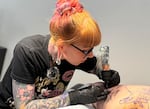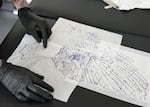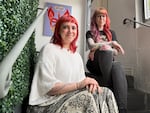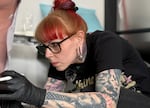
Tattoo artist Ruby Gore tattoos the outline of a giant harpy eagle onto her mentee, Selena Barnish, on May 16, 2025.
Mia Estrada / OPB
Note: This story touches on the topic of self-harm. If you or someone you know is struggling with self-harm, help is available: Call or text 988 to reach the Suicide and Crisis Lifeline.
Tattoo artist Ruby Gore is in her Southeast Portland studio, Black Thorne Tattoo, cutting up printed-out pages and taping them together to form a giant, majestic harpy eagle. It’ll soon be a tattoo on her client of the day.
“I’m gonna try it on her just to make sure that it’s still the right size,” she explained as she worked. “Then we’ll stencil it on her, and make her the proud owner of a new harpy!”
The future recipient of this tattoo, Selena Barnish, is very excited about it and brimming with relevant facts.
“I would say it’s my favorite bird. I could go on and on and on about how cool they are. Their claws are as long as bear claws, so they’re about 4 inches long, which is insane. They kind of look like animals that shouldn’t exist,” Barnish said.
The tattoo took Gore 16 hours to draw, and it’s all coming together now, as she delicately tapes the paper eagle onto Barnish’s right side, from knee to ribs. They stand together before a mirror.
“She fits! It’s a good size, we did it correctly,” Gore said.
“It’s incredible. It’s so beautiful. I had absolute confidence that it was gonna look amazing,” Barnish added.

Oregon tattoo artist Ruby Gore tapes together printed-out pages on her tattoo table to form the outline of a harpy eagle tattoo design on May 16, 2025.
Mia Estrada / OPB
This eagle, like all of her work, is custom, developed in collaboration with her clients. And it’s just her style, which she describes as scientific illustration, inspired by nature and biology.
But Barnish isn’t just here as her tattoo client today. Ruby Gore is also her mentor.
A few years ago, Barnish was in art school in Philly. When she was a sophomore in college, her mom had gone through breast cancer and gotten a double mastectomy. One day, Barnish was on Pinterest and saw a picture of a tattoo.
“The most beautiful scar cover-up on a double mastectomy. It was this fairy scene with deer, and I’ve never seen anything so ethereal. I think it was the connection of, ‘Oh my goodness, this is an option,” Barnish said.
“When I saw that, I was like, that’s what I want to do.”
Through some research, she discovered Gore and her work and reached out.
“When she asked me about my scar cover-up project, I 100,000% said ‘We need more people like you in the industry, so come on in and let me show you the way of scar cover-ups,’” Gore said.
This is one of Gore’s biggest specialties: scar cover-up tattoos, and more broadly, bringing a trauma-aware approach to tattooing.
OPB wanted to learn more about this healing part of her work and about what being a tattoo artist in Oregon is like. So we got to know Gore — who’s going by her artist name in this story — for the latest installment of OPB’s “At Work With” series, where we ask Pacific Northwesterners with interesting jobs your questions about what it’s like to do what they do.

Oregon tattoo artist Ruby Gore (right) and her mentee Selena Barnish sit on the front steps of Gore's private tattoo studio, Black Thorne Tattoo in Portland, Ore., in this portrait from May 16, 2025.
Mia Estrada / OPB
How did you get into scar cover-ups as a specialty?
It began when a client wanted to get a tattoo covering up a stretch mark. She told them she hadn’t done that before, but if they were comfortable with it, she was willing to give it a try with supervision.
“I just went in going, ‘OK, well this is just a different type of skin, but I’m gonna learn as I go and just be very, very careful.’ And it healed phenomenally. And I was so stoked.”
She posted it on Instagram, and someone reached out asking if she covered scars too. She took the same approach - carefully trying it out under supervision - and again, got great results. So she stuck with it.
One of our listeners wanted to know how she handles different textures of skin, like ridged or keloid scars. She said when people reach out to her with tattoo requests for scar cover-ups, she has them send her photos, for her internal use only.
“And if they look like they’re raised or keloided, anything other than very minimal, I will always have them come in so that I can actually feel the scar, because it’s really tough to tell.”
Each scar cover-up process is different, and Ruby’s gotten a feel for the nuances with experience. She says sometimes, it calls for creative thinking.
“Because it’s not always necessarily covering over the exact scar all the time. Because sometimes you can’t. Sometimes you have to distract away from the scar, sometimes you have to make the scar one with the piece,” she said.
What do you hear from clients about what scar cover-ups mean to them?
Gore has made scar cover-up work a centerpiece of her practice, even raffling off a free cover-up tattoo monthly through her “Out of the Darkness” survivor tattoo project. The longer she offers the service, the more she hears from clients how rare it is, how many other artists had turned them away.
“That’s causing more pain for that person. When they’re ready to move on to the next phase of their journey and tell a new story, and they just keep hitting a wall,” she said.
Ruby said a lot of what she does is cover-ups of scars from self-harm.
“And sometimes, it’s the tattoo that’s preventing them from going back to that, and that’s so powerful. It’s more powerful than I can comprehend.”
She remembers one client who really showed her how meaningful it can be. She’d done a large, color cover-up piece for the person, and they came in for a touch-up after the holidays one year.
“‘They were like, ‘I was actually able to go to Thanksgiving dinner, and realized that my family was staring because they thought that my tattoos were cool and not because they were staring at my scars,’” she remembered.
“Probably most of what I hear from people, is ‘I can’t wait to not answer questions about my scars anymore.’”
What is trauma-aware tattooing, and how do you integrate it into your work?
Scar cover ups aren’t the only healing work Gore does — she also focuses on bringing a trauma-aware care approach to tattooing. Trauma-aware tattooing recognizes that past experiences of trauma may come up for people during a tattoo session. She said this approach comes through in many ways throughout the tattoo process, and starts earlier than people think. It can include things like being extra communicative during booking, providing needed accommodations, getting consent before using a razor to shave a client’s skin, or spending extra time with someone to get a stencil on just right.
“Being really, really specific about this one thing that really means a lot to them, and that’s their safe space, and when they’re having a hard time that they can look down at that and that’s what’s grounding them? That is super important that we get that aligned right.”
Listening — or not, if they don’t feel like talking. Even just asking if people need a break.
“Back in the old school days of tattooing, hopefully these days are mostly behind us, but you would definitely hear stories of sitting down, getting tattooed and having to finish the tattoo because the person doing the tattoo said ‘we’re doing this,’ and just almost emotionally strong-arming you into it,” she said.
It’s happened to her before too.
“I never wanted to ever have anybody feel like that.”

Oregon tattoo artist Ruby Gore carefully tapes a printout of an eagle tattoo onto the right side of Selena Barnish, to check that its size is right, on May 16, 2025.
Mia Estrada / OPB
How did you become a tattoo artist?
It was the early 2010s. Gore was living in Portland, working an office job doing graphic design and email marketing.
“I think I was working in an open concept office with big fluorescent lights,” Gore recalled. “I like doing graphic design, but definitely all of those factors were just the opposite of the environment that I like to be in. I was trying really hard to make it work, but I was miserable.”
What she really was interested in was tattooing. She’d been fascinated with tattoos since she was a kid in San Diego. But the male-dominated tattoo scene in her hometown was intimidating.
“The one female that I knew that was a tattoo artist, I think she worked at a shop that was owned by Hell’s Angels. She was tough as nails too, like super, super sweet, but I looked at her and I was like, ‘I will never be like that. I am so soft and squishy on the inside,” she said.
So she didn’t pursue it. Until some friends who knew about her passion tipped her off to a local tattoo school in Portland. Before long, she sold her car, took out a loan and went for it. She remembers her first day of school — the day she got her artist name.
“They asked me what my artist name was and I froze. I don’t know, am I supposed to have one of those? And they were like, ‘Well, do you have a nickname?’ I was like, ‘Well, I used to play roller derby, my roller derby name was Ruby Gore,’ and so they were like, ‘Oh perfect, we’re just going to put that on all your things now.”
The name stuck.
“It was very much symbolic of the transition that I was going through and just becoming the person that I actually really wanted to be. It was a really powerful day,” she said.
What are some of the first tattoos you did when you were starting out?
The first tattoo Gore ever did on another person was a death moth on a guy she was dating at the time.
“It was, I don’t know, maybe like four inches. Um, it wasn’t as small as one should probably do their first tattoo. And it took way too long, and bless his heart for sitting there the entire time.”
And for herself, a tiny star on the wrist, with a tattoo kit her dad got her on eBay.
“I did my very first tattoo on me in my kitchen, like most tattoo artists do, and if they tell you otherwise they’re probably not telling the truth,” she said with a laugh.
How many tattoos do you have?
She can’t really say. They all start to blend together, the more you get. But she did come very ready with another statistic: “I can tell you how many bats I have. I think I’ve got 27, so that’s a number I could give you!”
How’d you and Selena end up in Oregon?
After years working in Philadelphia, she and her husband decided to move back to the Portland area last year to be closer to family. Gore asked her mentee, Selena Barnish, if she wanted to come.
“She was moving out to Oregon, and asked me if I would want to go with them and go to tattoo school in Oregon like she did, and she would still mentor me, and I remember walking to the subway afterwards just thinking, ‘did that actually happen?’” Barnish said.
Now she lives with them. Gore calls Barnish her niece. Barnish said Gore has modeled thinking of tattooing as a business - which they both say is surprisingly uncommon - and helped her become less timid. Once Barnish is done with tattoo school, she’ll have a table waiting for her at Black Thorne. When she’s ready, Gore said she’ll have Barnish do a tattoo for her that means a lot: a memorial portrait of her dog Domino, who died recently.
But for now, Barnish is here to get that big harpy eagle tattoo.
Gore creates a stencil using a special printer, rubs a cream on Barnish’s side and applies the stencil to her skin.
Before long, Barnish gets positioned on the table and Gore fires up her rotary tattoo machine, which is quieter than coil machines. She said it helps make the environment less stressful for clients whose nerves may already be on edge.
She starts with the biggest needle for thick lines first. Barnish described the sensation as like repetitive cat scratches.
“I don’t think I love the big liner. But I’m thinking about 60-year-old Selena, and she’s gonna be so glad that she did this when she was 23. So I’m doing this for her,” Barnish said.
Ruby Gore is clearly an inspiring mentor. It comes through in the way Selena Barnish talks about her future as a tattoo artist:
“I would like to be able to help people heal the way that she can help people heal. I think tattoos are very transformative, and they can be such a positive force for people. I’d like to, whatever my style is, be able to help people in that way,” Barnish said.

Oregon tattoo artist Ruby Gore, her hand covered in tattoos, tapes the outline of a harpy eagle onto Selena Barnish on May 16, 2025.
Mia Estrada / OPB
